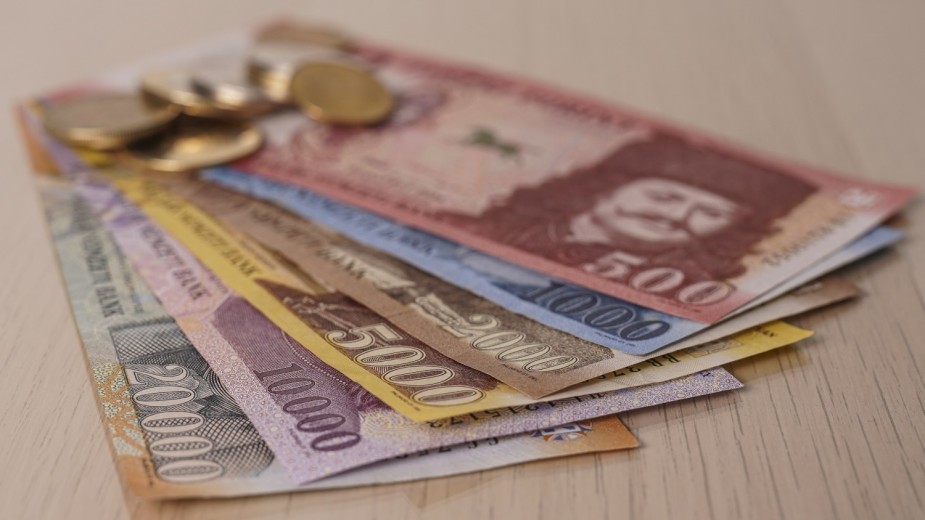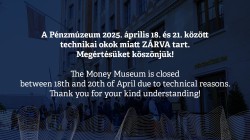
Since its creation a hundred years ago, the Central Bank of Hungary has issued two types of currency in the form of banknotes and coins: the pengő, which had a short but memorable life of just twenty years, and the forint, which is still in use today. Both have been repeatedly renewed, sometimes out of necessity, sometimes for security reasons or for modernisation. The 100 years of history are recalled through the banknotes and coins in the Money Museum.
After the First World War, rising inflation led to a gradual deterioration of the korona (the money used at the time), while gold reserves also declined. The monetary deterioration accelerated to such an extent that by mid-1924 it was clear that the crisis could only be overcome with external help. Financial help, a loan of 250 million gold crowns, came from the League of Nations, and an advance of £4 million from the Bank of England, which provided the precious metal backing needed for the new central bank, enabled the Central Bank of Hungary to be established in the June of 1924. The first president of the new institution was Sándor Popovics, a Doctor of Law, who had previously served as Minister of Finance and then President of the State Institute of Legal Affairs and was a member of the Hungarian Academy of Sciences. The loan from the People's League succeeded in curbing inflation, and in 1925 the law introducing the new gold-based currency and the pengő was passed. The value of a pengő was 12,500 crowns, but from 25 August 1926 the higher denomination so-called crown state banknotes were put into circulation overprinted in pengő according to the conversion rate, because the MNB's banknotes for the new currency had not yet been produced.
Lajos Kossuth "announced" the name of the new Hungarian currency
The choice of the name of the new currency was preceded by a heated debate, with the search for a name that had a tradition in Hungarian monetary history. Thus, the choice fell on the "pengő-forint", the name on the 1849 two-forint Kossuth banknote. The first pengő-denominated banknotes appeared in circulation at the end of 1926, in denominations of 5, 10, 20, 50 and 100 pengő. The 50 and 100 pengő notes bore the portraits of Ferenc Rákóczi II and King Mátyás respectively, the 5 pengő notes bore the portrait of István Széchenyi, the 10 pengő notes bore the portrait of Ferenc Deák, and the 20 pengő notes bore the portrait of Lajos Kossuth. The change of the new currency remained the old pengő. The first series of fillér was designed by Ferenc Helbing, while the 1,000 pengő banknote issued in 1927 was designed by Zoltán Egri. After the replacement of the first series of pengő banknotes, only one new banknote was put into circulation: a 10 pengő in 1936.
The territorial annexations between 1938 and 1941 - the southern part of the Highlands, Carpathia, Northern Transylvania, Bácska - required the central bank to print new banknotes to supply the affected parts of the country with cash. The 5 pengő banknotes survived for a year or two, before the 1 and 2 pengő coins, which were slowly being withdrawn from circulation, were replaced by paper notes of the same denomination.
Farewell to the Hungarian kingdom
Issuance of metallic coins of the pengő system started in 1926. In the first series, only 1 pengő was minted in silver, 50 pengő in nickel, 20 and 10 pengő in copper, 2 and 1 pengő in bronze, and from 1929 the 2 pengő was added. After the outbreak of the Second World War, when precious metals became a scarce commodity, the 5, 2 and 1 pengő denominations were minted in aluminium, and the changeover to iron for coins was made. The last metal coins with the inscription "Magyar Királyság" were produced in 1944, the last aluminium 5 pengő coins were issued in 1945. As the old Hungarian mint in Körmöcbánya was transferred to Czechoslovakia after the Treaty of Trianon, these coins were produced in the new Hungarian State Mint at the corner of Üllői út and Könyves Kálmán körút.
The end of the pengő and the world record
Although the Hungarian currency survived the Great Depression of 1929-33, the Second World War spared no one. The total damage amounted to 22 billion peace pengő, which represented about 40 percent of the national wealth. By the end of the Second World War, inflation in Hungary had again reached significant proportions, and this time it was impossible to contain it. For a long time, we Hungarians topped the world rankings in the financial world: we set a record with the hyperinflation of the pengő in 1946. In just under a year, the value of our official currency at the time, the pengő, fell to 41 900 000 000 000 000th (41.9 trillionth) of its original value, which was a daily average of 207% inflation. The world's largest denomination of pengő ever issued is still held by the Hungarian state one billion billpengő banknote, equivalent to 1,000 trillion pengős.
The national currency we use today is almost eighty years old
The pengő could no longer be saved, but thanks to the loyal and courageous employees on the Gold Train, using the approximately 30 tonnes of gold reserves of the Hungarian state, which had been exported and then brought back home, as collateral, a new national currency was introduced on the 1st of August in 1946: the gold-based forint. One forint was equivalent to 0.075 grams of fine gold and was converted into the fillér. The first forint coins in 1946 were made of aluminium. Many of you may remember the distinctive 1-forint coins with serrated edges and the later copper 2-forint coins, which were produced until 1990. In the year of issue, 2, 10 and 20 pfennigs and 1-, 2- and 5-forint denominations were produced. This series of coins was minted with minor changes and additions (5 and 50 pfennigs, 10 and 20 forints) until 1989. After the change of regime, circulation coins between 1 and 200 forints were issued with a completely new design. The fillér did not survive the regime change for long, and by 1999 all denominations were gradually withdrawn.
In 1993 the Central Bank of Hungary issued a new series of circulation coins in 5-10-20-50- and 100-forint denominations. In 1996 the 100-forint coin was changed to a bicolour design, while in 2009 the 200-forint coin was added to the denomination range. From the October 2019 the 100-forint was produced using copper alloy instead of steel while retaining the same design. Both the coins bearing the inscriptions "Republic of Hungary" and "Hungary" are legal tender, and the steel-based coins remain in circulation alongside the copper-alloy 100-forint coins.
Early forint banknotes are among the most beautiful currencies in the world
The first forint banknotes were the ten- and hundred-forint notes, but they were very easy to counterfeit because of their poor quality. However, the ten-, twenty-, fifty- and hundred-forint banknotes issued from 1947 onwards were so well made that they are still considered among the most beautiful banknote series in the world. Over the decades, however, the forint weakened, and larger and larger denominations were issued: in 1969, the 500-forint banknote with the portrait of Endre Ady, in 1983, the 1000 forint with Béla Bartók, and in 1990, the 5000-forint banknote with István Széchenyi (the first paper money to be in Braille). Finally, the central bank issued 10,000 and then 20,000-forint banknotes.
Changing coat of arms
The coat of arms on paper money has changed several times. When the first banknotes were issued, the Kossuth coat of arms was the symbol of Hungary, later replaced by the Rákosi coat of arms, which was in keeping with the socialist leadership. After the 1956 revolution, the Kossuth emblem became the country's emblem again, but it was so short-lived that it was not used on banknotes. The Kádár emblem was introduced in 1957, and the current crowned small emblem was introduced in 1990. The four 100-forint banknotes, which had been in circulation since 1948 and were subsequently affected by the changes in the coat of arms, were withdrawn from circulation uniformly on the 31st of December in 1998.
The Central Bank of Hungary renewed the banknote series issued from 1997 between 2014 and 2019. Its banknotes have all the visible and invisible features that guarantee modernity and reliable operation for all cash-flow participants. The graphic design of the current banknote series was created by graphic artist György Pálinkás.
Further news
All newsThank you for your kind understanding!
The Money Museum has been nominated for the Museum of the Year 2025 award by the Pulszky Society - Hungarian Museum Association jury.
Vote for the Money Museum and the Money Museum Panoramic Terrace!
The competition at the Money Museum is now closed and the winners have been announced.
Thank you for your kind understanding!
The Money Museum has been nominated for the Museum of the Year 2025 award by the Pulszky Society - Hungarian Museum Association jury.
Vote for the Money Museum and the Money Museum Panoramic Terrace!
The competition at the Money Museum is now closed and the winners have been announced.



